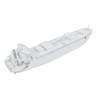Mitsubishi Heavy Industries, Ltd. (MHI) and Mitsubishi Hitachi Power Systems, Ltd. (MHPS) have jointly developed a Large-scale Rectangular Marine Scrubber that efficiently removes sulfur oxides (SOx) from the exhaust gases emitted by marine diesel engines.
The scrubber was developed based on MHPS's flue-gas treatment technologies cultivated through desulfurization systems for thermal power plants, leveraging MHI's expertise in marine engineering.
The adoption of a rectangular box-shape configuration - said to be a world first - offers ease of installation in small spaces and superlative emissions treatment for high-output engines used on large-scale containerships.
The new scrubber was developed in response to stringent new SOx emissions regulations that come into effect globally from 2020. It is able to purify exhaust gas emitted from inexpensive heavy fuel oil to a level equivalent to more expensive low-sulfur fuels, and has been designed to allow easy installation on existing ships.
The new SOx scrubber uses seawater as its cleaning agent, adopting a simple "open-loop" system in which seawater intake is sprayed directly on the exhaust gas. Effective use of seawater alkaline eliminates the need for chemicals or additional processing.
Further, because the horizontal and vertical dimensions of the rectangular scrubber tower can be freely modified, volume efficiency is higher than previous cylindrical scrubbers, providing space savings. The equipment configuration is simple, allowing easy installation not only in newly commissioned ships but in retrofitted vessels as well.
The scrubber's main unit can be set into the upper deck's engine casing, meaning it doesn't encroach on the ship's load space. This is particularly beneficial for large-scale containerships that use a "twin island" design structure. Going forward, MHPS will apply its expertise in local procurement and construction accrued through flue-gas treatment systems for land installations to the new marine scrubber, and will also focus on reducing costs.
Since 2015 the International Maritime Organization (IMO) requires sulfur content of less than 0.5 percent for marine fuels in designated emission control areas (ECA). However this will expand to all sea areas from 2020 when new regulations are introduced. Under the new regulatory structure the use of cheaper fuels with 3.5 percent sulfur content will still be allowed if equipment is installed that offers proportionate emissions reductions. This trend has precipitated the move to commercialize SOx scrubbers that are compliant with the new regulations.
The Large-scale Rectangular Marine Scrubber was unveiled by MHI and MHPS at the "Nor-Shipping 2017" maritime trade show in Oslo, Norway (from May 30 - June 2). Deliveries of the scrubber are expected from 2020 and, in preparation, both companies will seek certification from selected countries while conducting extensive tests on ships.
Sales offerings will focus on installations for both newly commissioned ships and ships already in service. This includes ships constructed by MHI, as well as ships built by other shipyards.
• 












